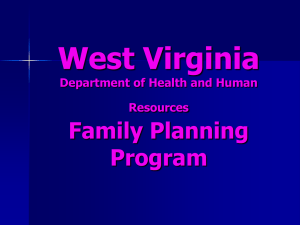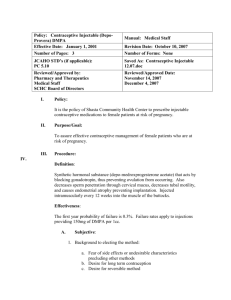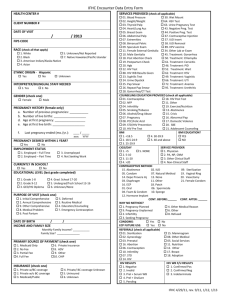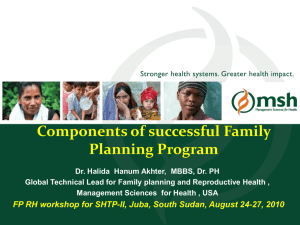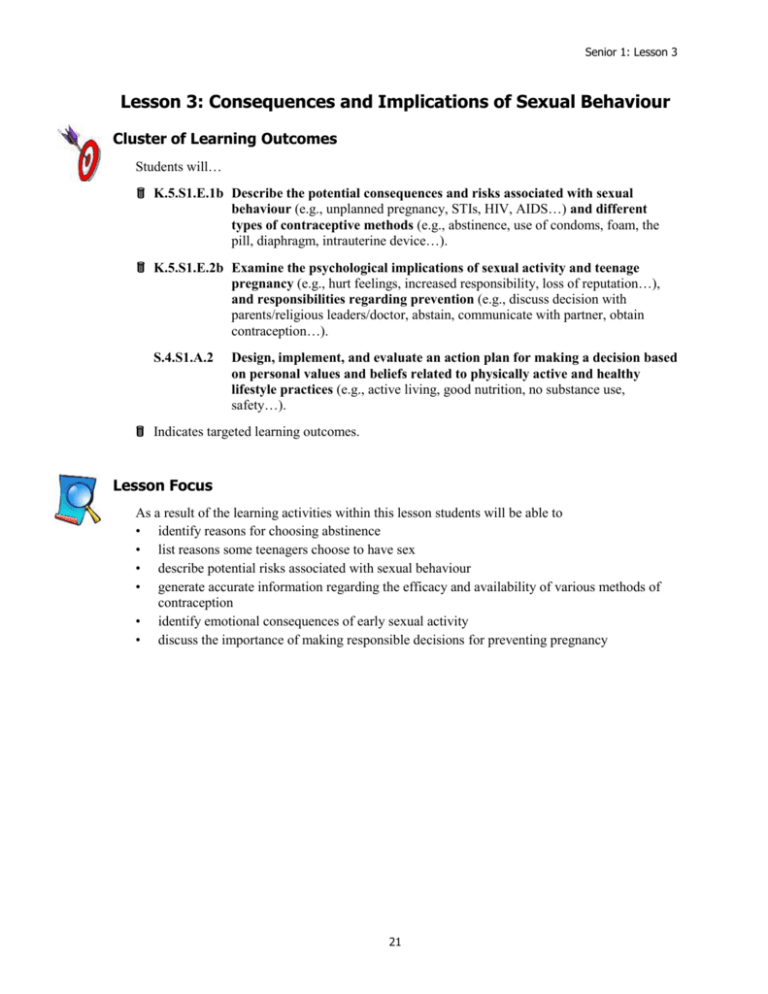
Senior 1: Lesson 3
Lesson 3: Consequences and Implications of Sexual Behaviour
Cluster of Learning Outcomes
Students will…
K.5.S1.E.1b Describe the potential consequences and risks associated with sexual
behaviour (e.g., unplanned pregnancy, STIs, HIV, AIDS…) and different
types of contraceptive methods (e.g., abstinence, use of condoms, foam, the
pill, diaphragm, intrauterine device…).
K.5.S1.E.2b Examine the psychological implications of sexual activity and teenage
pregnancy (e.g., hurt feelings, increased responsibility, loss of reputation…),
and responsibilities regarding prevention (e.g., discuss decision with
parents/religious leaders/doctor, abstain, communicate with partner, obtain
contraception…).
S.4.S1.A.2
Design, implement, and evaluate an action plan for making a decision based
on personal values and beliefs related to physically active and healthy
lifestyle practices (e.g., active living, good nutrition, no substance use,
safety…).
Indicates targeted learning outcomes.
Lesson Focus
As a result of the learning activities within this lesson students will be able to
• identify reasons for choosing abstinence
• list reasons some teenagers choose to have sex
• describe potential risks associated with sexual behaviour
• generate accurate information regarding the efficacy and availability of various methods of
contraception
• identify emotional consequences of early sexual activity
• discuss the importance of making responsible decisions for preventing pregnancy
21
Senior 1: Lesson 3
Resources
Blackline Master
• BLM S1-3.1: Postponing Intercourse Versus Having Intercourse
Resource Masters (See Appendix C)
• RM 3: Contraceptive Methods and Considerations
• RM 4: Pregnancy Prevention and Youth
• RM 5: Consequences of Teenage Pregnancy
Print/Publications
• Aboriginal Nurses Association of Canada and Planned Parenthood Federation of Canada.
Finding Our Way: A Sexual and Reproductive Health Sourcebook for Aboriginal
Communities. Ottawa, ON: Aboriginal Nurses Association of Canada and Planned
Parenthood Federation of Canada, 2002.
• Canadian Red Cross. RespectED: Violence and Abuse Prevention. Winnipeg, MB: Canadian
Red Cross, 2003.
• Planned Parenthood Federation of Canada. Beyond the Basics: A Sourcebook on Sexual and
Reproductive Health Education. Ottawa, ON: Planned Parenthood Federation of Canada,
2001. (See Module 7: Contraception and Safer Sex, pages 314-321.) Available online at:
<http://www.ppfc.ca>.
Organization/Website
• Birth control kits can be ordered from Sexuality Education Resource Centre (SERC),
Manitoba: <http://www.serc.mb.ca>.
Professionals
• Elder/religious leader
•
public health nurse
Notes to Teacher
Be sensitive to different cultural perspectives on reproductive health.
For background information on contraception and teenage pregnancy prevention, refer to
RMs 3 to 5 (in Appendix C).
Curricular Connections
PE/HE:
K.5.S1.E.2b
K.5.S1.E.1b
FS:
S1.2.3.2 Evaluate the role of abstinence in relationships, e.g., mental health, pregnancy
prevention, physical health—STIs, emotional health.
S1.2.4.1 Differentiate between different contraceptive options, e.g., abstinence, male condom,
male condom plus spermicide, female condom, birth control pill, no vaginal intercourse,
diaphragm and jelly, cervical cap, spermicides, IUCD, sponge, Depo-Provera, Norplant,
vasectomy, tubal ligation, rhythm method.
22
Senior 1: Lesson 3
Suggestions for Instruction
1. Life Is Too Short
Students define the following terms:
• sexual abstinence (e.g., refraining from any sexual activity that could cause pregnancy,
STIs, or HIV/AIDS)
• safer sex (e.g., use of contraceptive methods to reduce the risk of pregnancy, STIs, or
HIV/AIDS)
Working in pairs, students brainstorm
• reasons why some youth choose abstinence
• reasons why some youth choose to have intercourse
• potential risks of sexual behaviour (e.g., unplanned pregnancy, STIs, HIV/AIDS)
Pairs share their information with classmates.
To assist with class discussion, refer to BLM S1-3.1: Postponing Intercourse Versus
Having Intercourse.
2. Get the Facts…NOW!
As a class, brainstorm and create a master list of various types of contraceptive methods. If
desired, show a video or provide fact sheets on contraceptive methods prior to this learning
activity. Working in groups of three or four, students
• research the effectiveness of one contraceptive method related to pregnancy prevention
and STI prevention
• record information using the following chart
• present findings to classmates
Students complete their charts during class discussion.
Get the Facts…NOW!
Contraceptive
Method/Type
Rank Effectiveness*
to Protect Against
Pregnancy
Can Be Obtained
Where
STIs
* Rank effectiveness level of protection against pregnancy and STIs using a scale of 1 (least effective)
to 10 (most effective).
Refer to RM 3: Contraceptive Methods and Considerations
(see Appendix C).
3. Surprise Package
Prepare and distribute individual paper bags, each containing one type of contraceptive
device. Working in groups of three or four, students gather and present the following
information about a specific contraceptive device:
• name (e.g., condom)
• function (e.g., condom prevents semen from getting into the vagina and anus)
• effective use (e.g., for male condom, check expiration date, use once only)
Encourage appropriate class discussion.
4. Consider the Consequences
In groups of five or six, students brainstorm to identify the emotional consequences of early
sexual activity. Volunteers share their group’s information. Create a master list to generate
class discussion.
23
Senior 1: Lesson 3
5. What Am I to Do?
Remaining in the same groups (as in the previous learning activity), students analyze the
following statement:
“Your boyfriend/girlfriend says he/she is ready for sex.”
Each group examines the psychological implications of the above statement and addresses the
issue of making a responsible decision for preventing teenage pregnancy. Volunteers share
group answers. Encourage class discussion.
Suggestions for Assessment
Paper and Pencil Task: Get the Facts…NOW!
Self-Assessment: Inventory
Create a post-quiz to assess student knowledge. Post answers for students to self-assess
responses.
Contraceptive Methods
Suggested Questions:
1. What is the purpose/function of condoms?
2. What is the emergency contraceptive pill (morning-after pill) and what is its function?
3. What is a latex dam used for?
4. What are three highly unreliable contraceptive methods?
Answer Key:
1. Condoms form a barrier that prevents semen from getting into the vagina and anus.
2. An emergency contraceptive pill is given at a medical centre only in emergency
situations (e.g., forced intercourse, condom breakage). It may prevent unwanted
pregnancy.
3. A latex dam is used for oral sex as protection against STIs.
4. Three highly unreliable contraceptive methods are: natural family planning (rhythm),
withdrawal, and douching.
Journal/Learning Log: Consider the Consequences
Teacher Assessment: Anecdotal Notes
Students answer the following questions
in their journals/learning logs:
1. Imagine that you and your partner are expecting a baby. At this time in your life, how would
you handle the situation?
2. Is there a difference in how society views males having premarital sex versus females having
premarital sex? Explain.
3. How would being a teenage parent affect you and your life? Explain.
Journal/Learning Log: All Activities
Teacher Assessment: Anecdotal Notes
Students answer the following questions
in their journals/learning logs:
1. How does an individual’s life change when he or she is diagnosed with HIV? Explain.
2. There are various contraceptive methods. What factors would influence your selection?
Explain.
24

